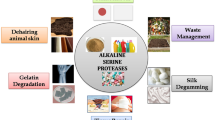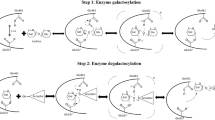Abstract
A novel intracellular β-galactosidases produced by Lactobacillus plantarum HF571129, isolated from an Indian traditional fermented milk product curd was purified and characterized. The β-galactosidases is a hetrodimer with a molecular weight of 60 kDa (larger subunit) and 42 kDa (smaller subunit), as estimated by sodium dodecyl sulphate-polyacrylamide gel electrophoresis (SDS-PAGE). The enzyme was purified 7.23 fold by ultrasonication, ultrafiltration and gel filtration chromatography with an overall recovery of 30.41 %. The optimum temperature for hydrolysis of its preferred substrates, o-nitrophenyl- β-D-galactopyranoside (ONPG) and lactose, are 50 °C (both), and optimum pH for these reactions is 6.5 and 7.5, respectively. The β-galactosidases showed higher affinity for ONPG (Km, 6.644 mM) as compared to lactose (Km, 23.28 mM). Galactose, the end product of lactose hydrolysis was found to be inhibited (47 %). The enzyme activity was drastically altered by the metal ion chelators EDTA, representing that this enzyme is a metalloenzyme. The enzyme was activated to a larger extent by Mg2+ (73 % at 1 mM), while inhibited at higher concentrations of Na+ (54 % at 100 mM), K+ (16 % at 100 mM) and urea (16 % at 100 mM). The thermal stability study indicated an inactivation energy of Ed = 171.37 kJ mol−1. Thermodynamic parameters such as ∆H, ∆S and ∆G, were determined as a function of temperature. About 88 % of lactose was hydrolyzed at room temperature within 1 h. The study suggested that this enzyme showed its obvious superiority in the industrial lactose conversion process.








Similar content being viewed by others
Abbreviations
- ∆H:
-
Enthalpy
- ∆G:
-
Gibbs free energy
- ∆S:
-
Entropy
- R:
-
Universal gas constant
- Kd :
-
Deactivation rate constants
- Vmax:
-
Maximum reaction velocity
- Km:
-
Michaelis–Menten constants
- Kcat:
-
Turn over number
- Kcat/Km:
-
Second order rate constant
- T:
-
Absolute temperature
- κ:
-
Boltzmann’s constant
- \( t\raisebox{1ex}{$1$}\!\left/ \!\raisebox{-1ex}{$2$}\right. \) :
-
Half-life time
References
Akolkar SK, Sajgure AD, Lele SS (2006) β -Galactosidase from Lactobacillus acidophilus isolated from fermented ragi. Indian J Biotechnol 5:184–188
Bergey DH, Harrison FC, Breed RS, Hammer BW, Huntoon FM (eds) (1923) Bergey’s manual of determinative bacteriology, 1st edn. The Williams & Wilkins Co, Baltimore, pp 1–442
Braga ARC, Manera AP, Ores JC, Sala L (2013) Kinetics and thermal properties of crude and purified β-Galactosidase with potential for the production of Galacto oligosaccharides. Food Technol Biotechnol 51:45–52
Chakraborti S, Sani RK, Banerjee UC, Sobti RC (2000) Purification and characterization of a novel β -galactosidase from Bacillus sp MTCC 3088. J Ind Microbiol Biotechnol 24:58–63
Choonia HS, Lele SS (2011) β -Galactosidase release kinetics during ultrasonic disruption of Lactobacillus acidophilus isolated from fermented Eleusine coracana. Food Bio Prod Process 89:288–293
Di Lauro B, Strazzulli A, Perugino G, La Cara F, Bedini E, Corsaro MM, Rossi M, Moracci M (2008) Isolation and characterization of a new family 42 β-galactosidase from the thermoacidophilic bacterium Alicyclobacillus acidocaldarius: identification of the active site residues. Biochim Biophys Acta 1784:292–301
Dickson RC, Markin JS (1980) Physiological studies of β-galactosidase induction in Kluveromyces lactis. J Bacteriol 142:777–785
Dwevedi A, Singh AK, Singh DP, Srivastava ON, Kayastha AM (2009) Lactose nano-probe optimized using response surface methodology. Biosens Bioelectron 25:784–790
Gheytanchi E, Heshmati F, Shargh BK, Nowroozi J (2010) Study on β -galactosidase enzyme produced by isolated lactobacilli from milk and cheese. Afr J Microbiol Res 4:454–458
Haider T, Husain Q (2007) Preparation of lactose free milk by using salt fractionated almond (Amygadalus communis) β-galactosidase. J Sci Food Agric 87:1278–1283
Hettwer DJ, Wang HY (1990) Protein release from chemically permeabilized Escherichia coli. In: Asenjo JA, Hong J (eds) Separation, recovery and purification in biotechnology—recent advances and mathematical modeling, ACS Symposium series 314. American Chemical Society, Washington, DC, pp 2–8
Hubber RE, Gupta MN, Khare SK (1994) The active site and mechanism of the β-galactosidase from Escherichia coli. Int J Biochem 26:309–318
Hung MN, Xia Z, Hu NT, Lee BH (2001) Molecular and biochemical analysis of two β-galactosidases from Bifidobacterium infantis HL96. Appl Environ Microbiol 67:4256–4263
Iqbal S, Nguyen T, Nguyen TT, Maischberger T (2010) β -Galactosidase from Lactobacillus plantarum WCFS1: biochemical characterization and formation of prebiotic galacto-oligosaccharides. Carbohydr Res 345:1408–1416
Joly M (1965) Physico-chemical approach to the denaturation of proteins. Academic, New York
Kim JW, Rajagopal SN (2000) Isolation and characterization of β-galactosidase from Lactobacillus crispatus. Folia Microbiol 45:29–34
Kleerebezem M, Boekhorst J, van Kranenburg R, Molenaar D (2003) Complete genome sequence of Lactobacillus plantarum WCFS1. Proc Natl Acad Sci U S A 100:1990–1995
Lowry OH, Rosebrough NJ, Farr AL, Randall RJ (1951) Protein measurement with the Folin phenol reagent. J Biol Chem 193:265–275
Mahalakshmi S, Kiran KK, Hameeda B, Gopal R (2013) Fermentative production of lactase from Lactobacillus amylophilus GV6. J Sci Ind Res 72:548–552
Maischberger T, Leitner E, Nitisinprasert S, Juajun O (2010) β Galactosidase from Lactobacillus pentosus: purification, characterization and formation of galacto oligosaccharides. Biotechnol J 5:838–847
Maisuria VB, Patel VA, Nerurkar AS (2010) Biochemical and thermal stabilization parameters of polygalacturonase from Erwinia carotovora subsp. carotovora BR1. J Microbiol Biotechnol 20:1077–1085
Neri DFM, Balcao VM, Carneiro MG, Carvalino LB, Teixeira JA (2008) Immobilization of β-galactosidase from Kluyveromyces lactis onto a polysiloxane-polyvinyl alcohol magnetic (mPOS-PVA) composite for lactose hydrolysis. Catal Commun 9:2334–2339
Nguyen TH, Splechtna B, Steinböck M, Kneifel W, Lettner HP, Kulbe KD, Haltrich D (2006) Homodimeric β-galactosidase from Lactobacillus delbrueckii subsp. bulgaricus DSM 20081: expression in Lactobacillus plantarum and Biochemical Characterization. J Agric Food Chem 54:4989–4998
Nguyen TH, Splechtna B, Krasteva S, Kneifel W, Kulbe KD, Divne C, Haltrich D (2007) Characterization and molecular cloning of a heterodimeric beta-galactosidase from the probiotic strain Lactobacillus acidophilus R22. FEMS Microbiol Lett 269:136–144
Pan Q, Zhu J, Liu L, Cong Y, Hu F, Li J (2010) Functional identification of a putative beta-galactosidase gene in the special lac gene cluster of Lactobacillus acidophilus. Curr Microbiol 60:172–178
Richmond ML, Gray JI, Stine CM (1981) Beta-galactosidase: review research related to technological application, nutritional concerns, and immobilization. J Dairy Sci 64:1759–1771
Sadana A (1995) Biocatalysis: fundamentals of deactivation kinetics. Prentice-Hall, Englewood Cliffs
Shuler ML, Kargi F (eds) (2005) Bioprocess Engineering-Basic Concepts. Prentice Hall of India Pvt. Ltd
Ustok FI, Tari C, Harsa S (2010) Biochemical and thermal properties of β-galactosidase enzymes produced by artisanal yoghurt cultures. Food Chem 119:1114–1120
Vinderola CG, Reinheimer JA (2003) Lactic acid starter and probiotic bacteria, a comparative “in vitro” study of probiotic characteristics and biological barrier resistance. J Food Res Int 36:895–904
Vrese M, Stegelmann A, Richter B, Fenselau S, Laue C, Schrezenmeir J (2001) Probiotics—compensation for lactase insufficiency. Am J Clin Nutr 73:421–429
Acknowledgments
The authors would like to thank VIT University, Vellore, India for supporting and performing the study. ES is obliged to the management of VIT for partial completion of doctoral works.
Conflict of interest
The authors declare that they have no conflict of interest.
Author information
Authors and Affiliations
Corresponding author
Rights and permissions
About this article
Cite this article
Selvarajan, E., Mohanasrinivasan, V. Kinetic studies on exploring lactose hydrolysis potential of β galactosidase extracted from Lactobacillus plantarum HF571129. J Food Sci Technol 52, 6206–6217 (2015). https://doi.org/10.1007/s13197-015-1729-z
Revised:
Accepted:
Published:
Issue Date:
DOI: https://doi.org/10.1007/s13197-015-1729-z




